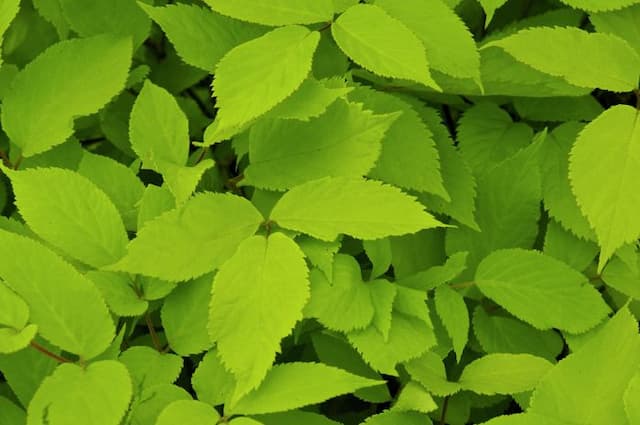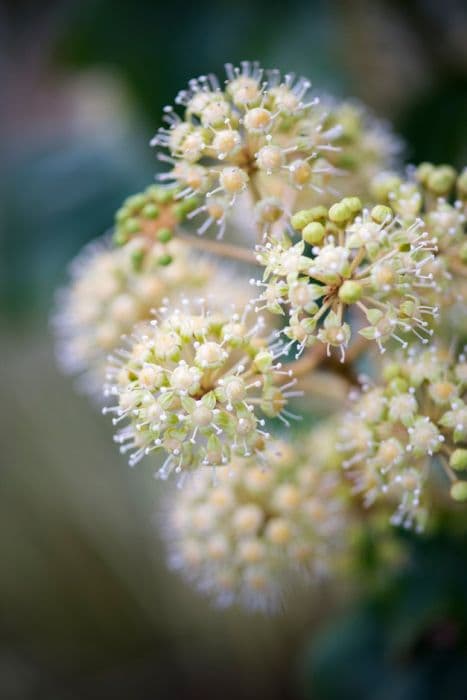English Ivy Hedera helix 'Arborescens'

ABOUT
The plant known as English ivy 'Arborescens' is a unique form of the classic ivy that is often seen climbing walls and trees. This particular variety differs in that it has a more shrub-like, bushy growth habit rather than being a climber. It sports glossy, dark green leaves that are typically three-lobed, although they can vary in shape. The leaves are leathery to the touch and can sometimes exhibit a slight waviness at the edges. During the period when the plant flowers, which is usually in the fall, it produces clusters of small, greenish-yellow flowers. These are not particularly showy, but they do add a subtle charm to the bushy green of the foliage. Following the flowering period, the plant may produce small, dark berries which are attractive to birds but are not suitable for human consumption as they can be toxic. English ivy 'Arborescens' is evergreen, so it retains its vibrant green foliage throughout the year, providing a continuous display of color. When planted outdoors, this plant may be used as a low-maintenance ground cover or as a standalone bush that provides some visual interest to the garden landscape. It can adapt to various light conditions, from full sun to partial shade, demonstrating its versatility as a garden plant. Due to its bushy form, it is also commonly used in landscaping to fill in areas or create low, informal hedges.
About this plant
 Names
NamesFamily
Araliaceae.
Synonyms
English Ivy, Common Ivy, European Ivy.
Common names
Hedera helix f. arborescens, Hedera helix var. arborescens.
 Toxicity
ToxicityTo humans
English ivy is considered toxic to humans. If any part of the plant is ingested, it can cause symptoms such as abdominal pain, vomiting, and diarrhea. In some cases, there can also be excessive salivation, inflammation of the skin, and difficulty in swallowing. The sap contains compounds that can irritate the skin and mucous membranes, so it’s essential to handle the plant with care and wash hands thoroughly after contact. If large quantities of the plant are consumed, it may result in more severe symptoms and should be treated as a medical emergency.
To pets
English ivy is also toxic to pets, such as cats and dogs. Ingestion of the leaves or berries can result in vomiting, diarrhea, abdominal pain, and hypersalivation. The plant contains several different toxins, including saponins, which can lead to drooling, choking, and swelling of the throat, potentially causing difficulty in breathing. Prolonged exposure or large amounts ingested can lead to severe health issues or even be fatal, so it's critical to keep pets away from the plant and seek veterinary care immediately if they consume any part of it.
 Characteristics
CharacteristicsLife cycle
Perennials
Foliage type
Evergreen
Color of leaves
Green
Height
1-2 feet (30-60 cm)
Spread
1-3 feet (30-90 cm)
Plant type
Shrub
Hardiness zones
5-9
Native area
Europe
Benefits
 General Benefits
General Benefits- Aesthetic appeal: Hedera helix 'Arborescens', commonly known as the English ivy, is valued for its lush evergreen foliage, adding year-round beauty and charm to gardens and landscapes.
- Erosion control: English ivy is often used to stabilize soil on slopes and prevent erosion due to its dense growth habit and strong root system.
- Low maintenance: Once established, English ivy requires minimal care, making it an ideal choice for gardeners seeking an easy-to-maintain plant.
- Versatility: The English ivy can be grown as a ground cover, climbing vine, or even trimmed into topiary shapes, making it versatile for a variety of garden designs.
- Habitat and food for wildlife: It provides habitat and berries that are a source of food for birds during the winter months when other resources are scarce.
- Privacy screen: When grown on fences or trellises, English ivy can create a dense screen, offering privacy and reducing noise pollution.
- Cooling effect: The dense foliage of English ivy can help cool down areas by providing shade and reducing the overall temperature in its immediate vicinity.
 Medical Properties
Medical Properties- Expectorant: English ivy may help to loosen mucus and relieve cough.
- Anti-inflammatory: The plant has been used for its potential to reduce inflammation.
- Antispasmodic: It has properties that may relieve spasms or cramps.
- Antimicrobial: Some studies indicate English ivy possesses antimicrobial activities.
 Air-purifying Qualities
Air-purifying QualitiesThis plant is not specifically known for air purifying qualities.
 Other Uses
Other Uses- Erosion Control: English Ivy 'Arborescens' can be planted to stabilize soil and to prevent erosion on slopes due to its dense growth habit.
- Topiary Art: The plant can be shaped into various forms and is often used in topiary art because of its dense foliage and ability to be trimmed into different shapes.
- Fabric Dye: The leaves of the plant have been traditionally used to produce a yellow or brown natural dye for coloring fabrics.
- Decorative Wreaths: The vines and leaves can be woven into wreaths and other decorations particularly during the holiday season.
- Green Roofing: English Ivy 'Arborescens' can be used in green roofing for its excellent ground covering ability, providing insulation and helping with temperature regulation.
- Sound Barrier: When grown densely, English Ivy 'Arborescens' can act as a sound barrier, reducing noise pollution.
- Privacy Screening: The plant is often used to create a living privacy screen along fences or walls due to its thick foliage.
- Wildlife Support: The berries of English Ivy 'Arborescens' can provide food for birds during the winter months when other food sources may be scarce.
- Culinary Decoration: While the plant is not edible, its leaves can be used as decorative plating elements in high-end culinary presentations.
- Photography and Film: Its picturesque appearance makes English Ivy 'Arborescens' a popular choice for use in photography and film as a backdrop or to set a scene.
Interesting Facts
 Feng Shui
Feng ShuiThe English Ivy is not used in Feng Shui practice.
 Zodiac Sign Compitability
Zodiac Sign CompitabilityThe English Ivy is not used in astrology practice.
 Plant Symbolism
Plant Symbolism- Connection: Ivy, the common name for Hedera helix, often symbolizes connection and friendship due to its tendency to intertwine and cling to structures and trees, representing the idea of sticking together through life's challenges.
- Eternity: Ivy is an evergreen plant, meaning it stays green all year round, which symbolizes eternity, continuity, and the immortal soul.
- Fidelity: Because ivy is known for its strong hold once it latches onto something, it symbolizes fidelity and enduring affection in relationships.
- Protection: In some cultures, ivy is believed to protect against evil spirits and is often used in wreaths and decorations for this purpose.
- Survival: Ivy's ability to grow in challenging conditions and even in the shade where other plants struggle represents resilience, survival, and determination.
- Good fortune: Ivy is sometimes associated with good luck, prosperity, and intellectual growth due to its vigorous and expanding nature.
 Water
WaterThe common ivy or English ivy, including the variety 'Arborescens', should be watered regularly, but with care to avoid waterlogging. During active growth in spring and summer, water every 7 to 10 days, ensuring that the top inch of soil is dry before watering again. Use about half a gallon of water per plant, making sure it's dispersed evenly around the base. In the fall and winter, reduce the frequency to every 10 to 14 days depending on indoor temperatures and humidity levels. Always check the soil moisture before watering to prevent overwatering which can lead to root rot.
 Light
LightEnglish ivy thrives in bright, indirect light, but can also adapt to low-light conditions. The best spot for 'Arborescens' is a location where it receives filtered sunlight, avoiding direct afternoon sun which can scorch the leaves. If positioned indoors, a north or east-facing window is ideal, or a few feet away from a south or west-facing window to ensure it gets the right amount of light without being damaged by direct rays.
 Temperature
TemperatureEnglish ivy prefers cooler temperatures, thriving in conditions around 50 to 70 degrees Fahrenheit. It can tolerate a minimum temperature of about 50 degrees Fahrenheit during the night and should not be subjected to temperatures above 90 degrees Fahrenheit, as this can stress the plant. Keep it in a well-ventilated area, away from drafts and extreme temperature changes for optimal growth.
 Pruning
PruningPruning English ivy is beneficial for maintaining its shape and encouraging fuller growth. Trim back overgrown or leggy stems in spring or early summer to promote bushier, new growth. Pruning can be done periodically throughout the growing season, but avoid heavy pruning in the fall as this can leave the plant vulnerable to damage in cold weather. The best time to prune is just before a growth spurt, typically in early spring.
 Cleaning
CleaningAs needed
 Soil
SoilEnglish Ivy 'Arborescens' thrives in a well-draining soil mix with a slightly acidic to neutral pH, typically ranging from 6.0 to 7.5. A mix of garden soil, peat moss, and perlite or sand in equal parts can create an ideal environment for this plant, promoting healthy root growth and adequate drainage.
 Repotting
RepottingEnglish Ivy 'Arborescens' should generally be repotted every two to three years, or when the roots have outgrown the current pot. This will ensure the plant has enough space to continue growing and prevent it from becoming pot-bound.
 Humidity & Misting
Humidity & MistingEnglish Ivy 'Arborescens' prefers a moderate to high humidity level, ranging from 40 to 70 percent. These conditions are particularly important during the dry winter months when indoor humidity can drop, potentially affecting the plant's health.
 Suitable locations
Suitable locationsIndoor
Place in bright, indirect light with some direct morning sun.
Outdoor
Plant in partial shade, protect from intense afternoon sun.
Hardiness zone
5-11 USDA
 Life cycle
Life cycleThe life of Hedera helix 'Arborescens', commonly known as the shrubby ivy, begins with germination from seed, which occurs in a warm and moist environment, with seeds typically spread by birds. Following germination, the seedling grows into a juvenile plant with long, trailing stems and lobed leaves, capable of climbing surfaces using aerial rootlets or sprawling on the ground. As the plant matures, it enters the adult stage, characterized by the development of woody stems and unlobed leaves, and it often shifts from a climbing or sprawling habit to a more upright shrubby form. The adult shrubby ivy then produces small, greenish-yellow flowers in umbels, which are pollinated by insects, primarily bees. After successful fertilization, the flowers develop into small, blackish berries, which are eaten and dispersed by birds, allowing the cycle to begin anew with germination. Throughout its life, shrubby ivy exhibits strong adaptability and can become evergreen, surviving for many years with the ability to withstand varied light and soil conditions, although it thrives best in shady or partially shaded locations.
 Propogation
PropogationPropogation time
Spring-Early Fall
The English Ivy 'Arborescens' is often propagated through stem cuttings, a popular method due to its simplicity and effectiveness. To propagate, select a healthy stem and cut a 4 to 6-inch (10 to 15 cm) length, making sure that there are at least two to three sets of leaves on the cutting. Remove the leaves from the lower half of the cutting to expose the nodes. These nodes, when buried in a soil mix, will develop roots. The cutting should then be placed in a container filled with a well-draining potting mix or a mixture of peat and perlite. To create a moist environment conducive to rooting, cover the container with plastic wrap or place it inside a propagator. Keep the cutting in indirect light and maintain a consistent temperature, ideally around 70°F (21°C), until roots develop, usually in a few weeks. Once the cuttings have rooted, they can be potted into individual containers.









